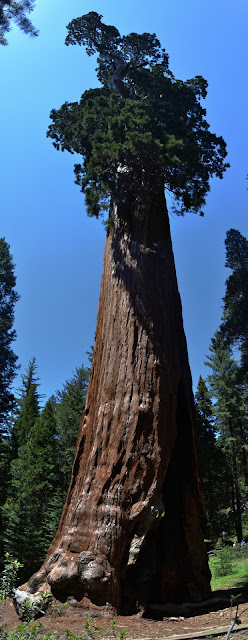Grant Grove
Kings Canyon National Park
Click for map.
I cannot pass up stopping by the big trees when we are so near and somehow Martha has never seen them. My original desire was to head up to the Garfield Grove, but the extra day for that is not working out after all. Considering how today is shaping up, it would have been a bit hot for the hike. My father seemed relieved to a surprising extreme to not have to find a different ride to the airport, so it works out for everyone to cut off a day of adventure. Instead of that remote grove that we might have all to ourselves, we head over to the paved and fenced Grant Grove, which we will have to share with tourists that arrive by the busload plus those in dozens of cars. It was once part of the General Grant National Park, one of the first four national parks, but is now a part of the much younger Kings Canyon National Park. Importantly, it has sequoiadendron giganteum, and some of them are quite large ones.

Signs tell us cultural history and bits about the trees. I expect to see something about fire on one of the first two, but it takes quite a few signs to get around to it. On the way, there is plenty of evidence of fire.

After we pass the log, which is so unenthusiastic to decay into the ground that it looks much the same now as when it was housing soldiers who were the first park protectors, there is the massive Centennial Stump which is 24 feet across. This one was cut in 1875 for exhibition and was confidently called a hoax by those in the east. Past that is the cabin those first white settlers built when they tired of living in a fallen tree. The thick redwood is still standing strong and solid. They were cattle or sheep herders, depending on if we read the old or new sign, and tried a little timber as well. Finally, there is General Grant himself.

General Grant has quite a crowd. A sign points the way up a hill, which the park clearly does not think is accessible but has an electric wheelchair navigating it anyway, to see the general's fire scar. Other signs give a lot more information, some of it in very silly ways. It is the third largest tree known in the world, by volume and the widest known sequoia. That width is 40 feet and the height is 268 feet. It is a very big tree.

We take some time to marvel as the tree silently towering over us and read all the honors that have been bestowed upon it over the years, certain that the tree does not care, then finish the stroll around the loop past a few more sequoia.

©2017 Valerie Norton
Posted 13 July 2017
Liked this? Interesting? Click the three bars at the top left for the menu to read more or subscribe!




Comments